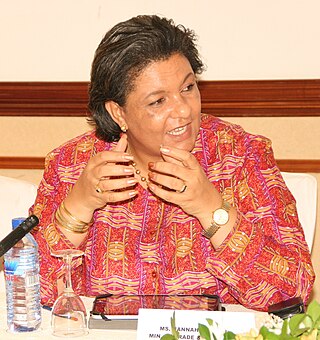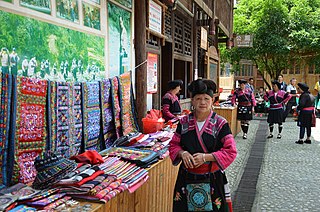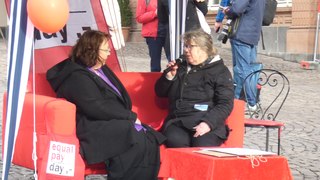Related Research Articles

Sexism is prejudice or discrimination based on one's sex or gender. Sexism can affect anyone, but primarily affects women and girls. It has been linked to gender roles and stereotypes, and may include the belief that one sex or gender is intrinsically superior to another. Extreme sexism may foster sexual harassment, rape, and other forms of sexual violence. Discrimination in this context is defined as discrimination toward people based on their gender identity or their gender or sex differences. An example of this is workplace inequality. Sexism may arise from social or cultural customs and norms.
A gender role, also known as a sex role, is a social role encompassing a range of behaviors and attitudes that are generally considered acceptable, appropriate, or desirable for a person based on that person's sex. Gender roles are usually centered on conceptions of masculinity and femininity, although there are exceptions and variations.
Workfare is a governmental plan under which welfare recipients are required to accept public-service jobs or to participate in job training. Many countries around the world have adopted workfare to reduce poverty among able-bodied adults; however, their approaches to execution vary. The United States and United Kingdom are two countries utilizing workfare, albeit with different backgrounds.
Feminization of poverty refers to a trend of increasing inequality in living standards between men and women due to the widening gender gap in poverty. This phenomenon largely links to how women and children are disproportionately represented within the lower socioeconomic status community in comparison to men within the same socioeconomic status. Causes of the feminization of poverty include the structure of family and household, employment, sexual violence, education, climate change, "femonomics" and health. The traditional stereotypes of women remain embedded in many cultures restricting income opportunities and community involvement for many women. Matched with a low foundation income, this can manifest to a cycle of poverty and thus an inter-generational issue.

Sociology of the family is a subfield of the subject of sociology, in which researchers and academics study family structure as a social institution and unit of socialization from various sociological perspectives. It can be seen as an example of patterned social relations and group dynamics.

Although women in Japan were recognized as having equal legal rights to men after World War II, economic conditions for women remain unbalanced. Modern policy initiatives to encourage motherhood and workplace participation have had mixed results.
Employment discrimination is a form of illegal discrimination in the workplace based on legally protected characteristics. In the U.S., federal anti-discrimination law prohibits discrimination by employers against employees based on age, race, gender, sex, religion, national origin, and physical or mental disability. State and local laws often protect additional characteristics such as marital status, veteran status and caregiver/familial status. Earnings differentials or occupational differentiation—where differences in pay come from differences in qualifications or responsibilities—should not be confused with employment discrimination. Discrimination can be intended and involve disparate treatment of a group or be unintended, yet create disparate impact for a group.
The gender pay gap in the United States is a measure between the earnings of male and females in the workforce. When calculating the pay gap, non-adjusted versus adjusted pay gap is utilized. The adjusted pay gap takes into consideration the differences in hours worked, occupations chosen, education and job experience, whereas the non-adjusted pay gap is the overall difference of gross hourly earnings of males and females in the United States. The non-adjusted average female annual salary is around 80% of the average male salary, compared to 95% for the adjusted average salary.
Family economics applies economic concepts such as production, division of labor, distribution, and decision making to the family. It is used to explain outcomes unique to family—such as marriage, the decision to have children, fertility, time devoted to domestic production, and dowry payments using economic analysis.

The status of women in Ghana and their roles in Ghanaian society has changed over the past few decades. There has been a slow increase in the political participation of Ghanaian women throughout history. Women are given equal rights under the Constitution of Ghana, yet disparities in education, employment, and health for women remain prevalent. Additionally, women have much less access to resources than men in Ghana do. Ghanaian women in rural and urban areas face slightly different challenges. Throughout Ghana, female-headed households are increasing.
A working parent is a father or a mother who engages in a work life. Contrary to the popular belief that work equates to efforts aside from parents' duties as a childcare provider and homemaker, it is thought that housewives or househusbands count as working parents. The variations of family structures include, but are not limited to, heterosexual couples where the father is the breadwinner and the mother keeps her duties focused within the home, homosexual parents who take on a range of work and home styles, single working mothers, and single working fathers. There are also married parents who are dual-earners, in which both parents provide income to support their family. Throughout the 20th century, family work structures experienced significant changes. This was shown by the range of work opportunities each parent was able to take and was expected to do, to fluctuations in wages, benefits, and time available to spend with children. These family structures sometimes raise much concern about gender inequalities. Within the institution of gender, there are defined gender roles that society expects of mothers and fathers that are reflected by events and expectations in the home and at work.
Maternalism is the public expression of domestic values associated with motherhood. It centers on the language of motherhood to justify women's political activities, actions and validate state or public policies. Maternalism is an extension of "empowered motherhood." It defines itself as the extension of feminine moral values of nurturance and care and the home's social caring into a larger community. Under maternalism, the mother-child relationship is essential for maintaining a healthy society. All women are seen united and defined by their ability and shared responsibility to mother to all children. Using the foundations of motherhood, mothers within maternalism provide a service to the state or nation by raising "citizen-workers." 20th and 21st-century scholars have shed light on women activists in the context of maternalist politics focused on policies designed to benefit women and children, such as maternal and child health care programs, mother pensions like the ADC program and other various welfare programs. Some scholars consider maternalism to be part of feminist movements and ideologies. On the other hand, others consider it to be different from feminism due to some maternalists incorporating a shared characteristic that the male figure in the household should be the economic provider and that a woman's central role is as a mother.
Work–family balance in the United States differs significantly for families of different social class. This differs from work–life balance: while work–life balance may refer to the health and living issues that arise from work, work–family balance refers specifically to how work and families intersect and influence each other.
Shared earning/shared parenting marriage, also known as peer marriage, is a type of marriage where partners at the outset agree to adhere to a model of shared responsibility for earning money, meeting the needs of children, doing household chores, and taking recreation time in near equal fashion across these four domains. It refers to an intact family formed in the relatively equal earning and parenting style from its initiation. Peer marriage is distinct from shared parenting, as well as the type of equal or co-parenting that father's rights activists in the United States, the United Kingdom and elsewhere seek after a divorce in the case of marriages, or unmarried pregnancies/childbirths, not set up in this fashion at the outset of the relationship or pregnancy.

In 2021, China ranked 48th out of 191 countries on the United Nations Development Programme's Gender Inequality Index (GII). Among the GII components, China's maternal mortality ratio was 32 out of 100,000 live births. In education 58.7 percent of women age 25 and older had completed secondary education, while the counterpart statistic for men was 71.9 percent. Women's labour power participation rate was 63.9 percent, and women held 23.6 percent of seats in the National People's Congress. In 2019, China ranked 39 out of the 162 countries surveyed during the year.
In South Korea, gender inequality is derived from deeply rooted patriarchal ideologies with specifically defined gender-roles. While it remains especially prevalent in South Korea's economy and politics, gender inequality has decreased in healthcare and education.
Gender inequality in the United States has been diminishing throughout its history and significant advancements towards equality have been made beginning mostly in the early 1900s. However, despite this progress, gender inequality in the United States continues to persist in many forms, including the disparity in women's political representation and participation, occupational segregation, and the unequal distribution of household labor. The alleviation of gender inequality has been the goal of several major pieces of legislation since 1920 and continues to the present day. As of 2021, the World Economic Forum ranks the United States 30th in terms of gender equality out of 149 countries.

The gender pay gap or gender wage gap is the average difference between the remuneration for men and women who are working. Women are generally found to be paid less than men. There are two distinct numbers regarding the pay gap: non-adjusted versus adjusted pay gap. The latter typically takes into account differences in hours worked, occupations chosen, education and job experience. In the United States, for example, the non-adjusted average woman's annual salary is 79–83% of the average man's salary, compared to 95–99% for the adjusted average salary.

Women in Guyana are a cross-section of Asian, African, and indigenous backgrounds. British colonization and imperialism have contributed to the sexism against Guyanese women in the household, politics, and education.
Even as a highly developed and modern society, Japan still has moderate levels of gender inequality. In 2015, the country had a per-capita income of US$38,883, ranking 22nd of the 188 countries, and No. 18 in the Human Development Index. Its Gender Inequality Index rank was 17th on the 2019 report ahead of Germany, the UK and the US, performing especially well on the reproductive health and higher education attainment indices. Despite this, gender inequality still exists in Japan due to the persistence of gender norms in Japanese society. Gender-based inequality manifests in various aspects of social life in Japan, from the family to political representation, playing particular roles in employment opportunities and income, and occurs largely as a result of differing gender roles in traditional and modern Japanese society. Inequality also lies within divorce and the marriage of same sex couples due to both a lack of protective divorce laws and the presence of restrictive marriage laws; discrimination exists outside of the law and is present in the modern day society of Japan.
References
- ↑ "breadwinner". Longman Dictionary of Contemporary English. Pearson ELT.
- ↑ "History 1700". faculty.weber.edu. Retrieved 2023-01-02.
- ↑ Bjørnholt, Margunn (2014). "Changing men, changing times; fathers and sons from an experimental gender equality study" (PDF). The Sociological Review . 62 (2): 295–315. doi:10.1111/1467-954X.12156. S2CID 143048732.
- ↑ Wang, Wendy (29 May 2013). "Breadwinner Moms". Pew Research Center Social & Demographic Trends. Retrieved 9 June 2017.
- ↑ Seccombe, Wally (Jan 1986). "Patriarchy Stabilized: The Construction of the Male Breadwinner Wage Norm in Nineteenth-Century Britain". Social History. Taylor & Francis, Ltd. 11 (1): 53–76. doi:10.1080/03071028608567640. JSTOR 4285488.
- ↑ Strange, Julie-Marie (December 2012). "Fatherhood, Providing and Attachment in Late Victorian and Edwardian Working-Class Families". The Historical Journal. Cambridge University Press. 55 (4): 1007–1027. doi:10.1017/s0018246x12000404. S2CID 144726797.
- ↑ Seccombe
- ↑ "Exhibitions | Citizenship | Struggle for democracy". The National Archives. Retrieved 2016-02-25.
- ↑ D'Amico, Ronald (Jun 1983). "Status Maintenance or Status Competition? Wife's Relative Wages as a Determinant of Labor Supply and Marital Instability". Social Forces. Oxford University Press. 61 (4): 1186–1205. doi:10.2307/2578286. JSTOR 2578286.
- ↑ Kaur, Ravneet; Garg, Suneela (April 2008). "Addressing Domestic Violence Against Women: An Unfinished Agenda". Indian Journal of Community Medicine. 33 (2): 73–76. doi: 10.4103/0970-0218.40871 . ISSN 0970-0218. PMC 2784629 . PMID 19967027.
- 1 2 3 Pascall, Gillian (2010), "Male breadwinner model", in Pascall, Gillian; et al. (eds.), International encyclopedia of social policy, London New York: Routledge, ISBN 9780415576949 Text.
- ↑ www.apa.org https://www.apa.org/news/press/releases/2011/12/working-moms . Retrieved 2023-01-02.
{{cite web}}: Missing or empty|title=(help) - ↑ Medved, Caryn E. (2016-07-02). "The new female breadwinner: discursively doing and un doing gender relations". Journal of Applied Communication Research. 44 (3): 236–255. doi:10.1080/00909882.2016.1192286. ISSN 0090-9882. S2CID 148367384.
- ↑ Parker, Kim; Stepler, Renee. "Americans see men as the financial providers, even as women's contributions grow". Pew Research Center. Retrieved 2023-01-02.
- ↑ Dugan, Emily (19 February 2014). "Number of women in work in Britain hits record high – but figures show the gender pay gap is growing too". The Independent . Independent Print Limited. Retrieved 30 October 2014.
- ↑ Crompton, Rosemary (1999). Restructuring gender relations and employment: the decline of the male breadwinner. Oxford New York: Oxford University Press. ISBN 9780198296089.
- ↑ Cunningham, Mick (September 2008). "Changing attitudes toward the male breadwinner, female homemaker family model: Influences of women's employment and education over the lifecourse". Social Forces . Oxford Journals. 87 (1): 299–323. doi:10.1353/sof.0.0097. JSTOR 20430858. S2CID 144490888.
- 1 2 Sayer, Liana C.; Bianchi, Suzanne M.; Robinson, John P. (July 2004). "Are parents investing less in children? Trends in mothers' and fathers' time with children". American Journal of Sociology . The University of Chicago Press. 110 (1): 1–43. doi:10.1086/386270. JSTOR 10.1086/386270. S2CID 141718530.
- ↑ Lewis, Jane (Summer 2001). "The decline of the male breadwinner model: The implications for work and care". Social Politics . Oxford Journals. 8 (2): 152–170. doi:10.1093/sp/8.2.152.
- ↑ Nadim, Marjan (January 29, 2015). "Undermining the Male Breadwinner Ideal? Understandings of Women's Paid Work among Second-Generation Immigrants in Norway". Sociology. 50 (1): 109–124. doi:10.1177/0038038514560259. hdl: 11250/2561247 . S2CID 55690788 – via Sage Journals.
- ↑ World Economic Forum (2013). Insight Report: The Global Gender Gap Report 2013 (PDF) (Report). World Economic Forum, Switzerland. p. 103. Retrieved 19 October 2014.
- 1 2 Wang, Wendy; Parker, Kim; Taylor, Paul (29 May 2013). Breadwinner moms, mothers are the sole or primary provider in four-in-ten households with children: Public conflicted about the growing trend (PDF). Pew Research Center (Report). Washington, DC. Archived from the original (PDF) on 6 November 2014. Retrieved 1 November 2014.
- 1 2 Pew Research Center (19 November 2010). The decline of marriage and rise of new families (Report). Pew Research Center. Retrieved 18 October 2014.
- ↑ Creighton, Colin (September 1999). "The rise and decline of the 'male breadwinner family' in Britain". Cambridge Journal of Economics . Oxford Journals. 23 (5): 519–541. doi:10.1093/cje/23.5.519. JSTOR 23599633.
- ↑ Thaler, Richard H. (1 June 2013). "Breadwinner wives and nervous husbands". The New York Times . Retrieved 18 October 2014.
- 1 2 Marjan Nadim (February 2016). "Undermining the Male Breadwinner Ideal? Understandings of Women's Paid Work among Second-Generation Immigrants in Norway". Sociology. 50 (1): 109–124. doi:10.1177/0038038514560259. hdl: 11250/2561247 . S2CID 55690788.
- ↑ Boje, Thomas P. (July 2007). "Welfare and work. The gendered organisation of work and care in different European Countries". European Review. 15 (3): 373–395. doi:10.1017/S1062798707000361. ISSN 1474-0575. S2CID 143926974.
- ↑ Levy, Jonathan (2021). Ages of American capitalism: a history of the United States. New York. ISBN 978-0-8129-9502-2. OCLC 1162599712.
{{cite book}}: CS1 maint: location missing publisher (link) - ↑ Al-Jubari, Ibrahim; Mosbah, Aissa; Salem, Suha Fouad (July 2022). "Employee Well-Being During COVID-19 Pandemic: The Role of Adaptability, Work-Family Conflict, and Organizational Response". SAGE Open. 12 (3): 215824402210961. doi:10.1177/21582440221096142. ISSN 2158-2440. S2CID 251691776.
- 1 2 Fan, Wen; Moen, Phyllis (May 2022). "Working More, Less or the Same During COVID-19? A Mixed Method, Intersectional Analysis of Remote Workers". Work and Occupations. 49 (2): 143–186. doi: 10.1177/07308884211047208 . ISSN 0730-8884.